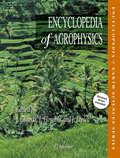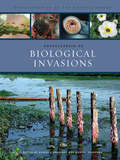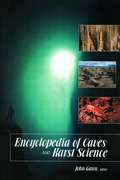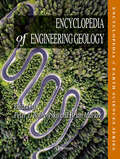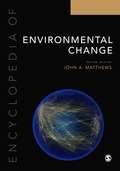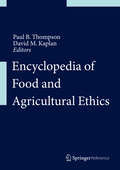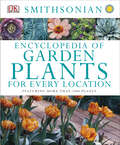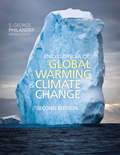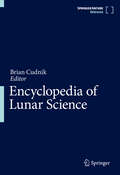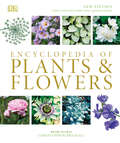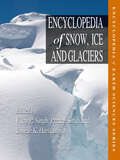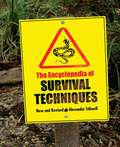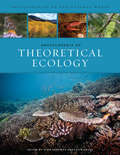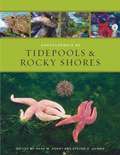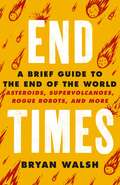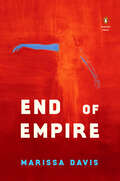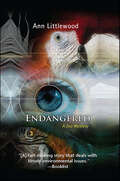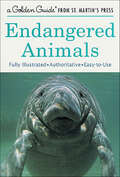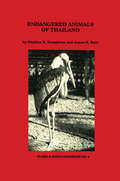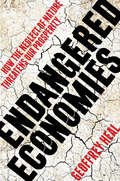- Table View
- List View
Encyclopedia of Agrophysics
by Charles W. Finkl Rainer Horn Eugene V. Shein Jan Gliński Jerzy Lipiec Josse De Baerdemaeker Józef Horabik Krystyna Konstankiewicz Stanislaw Grundas Winfried E. Blum Yakov PachepskyThis Encyclopedia of Agrophysics will provide up-to-date information on the physical properties and processes affecting the quality of the environment and plant production. It will be a "first-up" volume which will nicely complement the recently published Encyclopedia of Soil Science, (November 2007) which was published in the same series. In a single authoritative volume a collection of about 250 informative articles and ca 400 glossary terms covering all aspects of agrophysics will be presented. The authors will be renowned specialists in various aspects in agrophysics from a wide variety of countries. Agrophysics is important both for research and practical use not only in agriculture, but also in areas like environmental science, land reclamation, food processing etc. Agrophysics is a relatively new interdisciplinary field closely related to Agrochemistry, Agrobiology, Agroclimatology and Agroecology. Nowadays it has been fully accepted as an agricultural and environmental discipline. As such this Encyclopedia volume will be an indispensable working tool for scientists and practitioners from different disciplines, like agriculture, soil science, geosciences, environmental science, geography, and engineering.
Encyclopedia of Biological Invasions
by Daniel Simberloff Marcel RejmanekThis pioneering encyclopedia illuminates a topic at the forefront of global ecology--biological invasions, or organisms that come to live in the wrong place. Written by leading scientists from around the world, Encyclopedia of Biological Invasions addresses all aspects of this subject at a global level--including invasions by animals, plants, fungi, and bacteria--in succinct, alphabetically arranged articles. Scientifically uncompromising, yet clearly written and free of jargon, the volume encompasses fields of study including biology, demography, geography, ecology, evolution, sociology, and natural history. Featuring many cross-references, suggestions for further reading, illustrations, an appendix of the world's worst 100 invasive species, a glossary, and more, this is an essential reference for anyone who needs up-to-date information on this important topic. Encyclopedia of Biological Invasions features articles on: * Well-known invasive species such the zebra mussel, chestnut blight, cheatgrass, gypsy moth, Nile perch, giant African snail, and Norway rat * Regions with especially large numbers of introduced species including the Great Lakes, Mediterranean Sea, Hawaiian Islands, Australia, and New Zealand. * Conservation, ecological, economic, and human and animal health impacts of invasions around the world * The processes and pathways involved in invasion * Management of introduced species
Encyclopedia of Caves and Karst Science
by John GunnThe Encyclopedia of Caves and Karst Science contains 350 alphabetically arranged entries. The topics include cave and karst geoscience, cave archaeology and human use of caves, art in caves, hydrology and groundwater, cave and karst history, and conservation and management. The Encyclopedia is extensively illustrated with photographs, maps, diagrams, and tables, and has thematic content lists and a comprehensive index to facilitate searching and browsing.
Encyclopedia of Engineering Geology (Encyclopedia Of Earth Sciences Ser.)
by Peter T. Bobrowsky Claudio Margottini Paul Marinos Brian Marker Martin G. Culshaw Jerome De Graff Laurance Donnelly Michael Hendry Jeffrey R. Keaton Victor Osipov Abdul Shakoor Roy ShlemonThis volume addresses the multi-disciplinary topic of engineering geology and the environment, one of the fastest growing, most relevant and applied fields of research and study within the geosciences. It covers the fundamentals of geology and engineering where the two fields overlap and, in addition, highlights specialized topics that address principles, concepts and paradigms of the discipline, including operational terms, materials, tools, techniques and methods as well as processes, procedures and implications.A number of well known and respected international experts contributed to this authoritative volume, thereby ensuring proper geographic representation, professional credibility and reliability. This superb volume provides a dependable and ready source of information on approximately 300 topical entries relevant to all aspects of engineering geology. Extensive illustrations, figures, images, tables and detailed bibliographic citations ensure that the comprehensively defined contributions are broadly and clearly explained.The Encyclopedia of Engineering Geology provides a ready source of reference for several fields of study and practice including civil engineers, geologists, physical geographers, architects, hazards specialists, hydrologists, geotechnicians, geophysicists, geomorphologists, planners, resource explorers, and many others. As a key library reference, this book is an essential technical source for undergraduate and graduate students in their research. Teachers/professors can rely on it as the final authority and the first source of reference on engineering geology related studies as it provides an exceptional resource to train and educate the next generation of practitioners.
Encyclopedia of Environmental Change: Three Volume Set
by John A MatthewsAccessibly written by a team of international authors, the Encyclopedia of Environmental Change provides a gateway to the complex facts, concepts, techniques, methodology and philosophy of environmental change. This three-volume set illustrates and examines topics within this dynamic and rapidly changing interdisciplinary field. The encyclopedia includes all of the following aspects of environmental change: Diverse evidence of environmental change, including climate change and changes on land and in the oceans Underlying natural and anthropogenic causes and mechanisms Wide-ranging local, regional and global impacts from the polar regions to the tropics Responses of geo-ecosystems and human-environmental systems in the face of past, present and future environmental change Approaches, methodologies and techniques used for reconstructing, dating, monitoring, modelling, projecting and predicting change Social, economic and political dimensions of environmental issues, environmental conservation and management and environmental policy Over 4,000 entries explore the following key themes and more: Conservation Demographic change Environmental management Environmental policy Environmental security Food security Glaciation Green Revolution Human impact on environment Industrialization Landuse change Military impacts on environment Mining and mining impacts Nuclear energy Pollution Renewable resources Solar energy Sustainability Tourism Trade Water resources Water security Wildlife conservation The comprehensive coverage of terminology includes layers of entries ranging from one-line definitions to short essays, making this an invaluable companion for any student of physical geography, environmental geography or environmental sciences.
Encyclopedia of Food and Agricultural Ethics
by Paul B. Thompson David M. KaplanThe field of agricultural and food ethics emerged in the 1980 s as scholars began to recognize the need for explicitly normative scholarship on problems and issues associated with the food system. After 25 years of growth, agricultural and food ethics have blossomed in the wake of food safety scandals and renewed interest in alternative ways to organize the agrifood system. There has been a rapid growth in courses taught and in the entry of new researchers into the topics of agricultural and food ethics over the last five years. Scholarship has now reached a point where there is a need for a cross-cutting reference volume that will enable newcomers to the field to gain orientation to the array of topics and problems, existing scholarship on these topics and problems, and key concepts that have been established in agricultural and food ethics. Active scholars in the field would also benefit from literature reviews and survey articles that facilitate a more cumulative trend in research efforts. "
Encyclopedia of Garden Plants for Every Location: Featuring More Than 3,000 Plants
by DKDiscover everything you need to transform your empty plot into a stunning garden oasis with this gardening encyclopedia.This horticultural gem includes more than 2,000 recommendations from gardening experts and features valuable information and advice to expand on your gardening ideas. Planning your garden has never been this easy with this informative planting guide that every gardener needs on their bookshelf. Here&’s what you&’ll find inside: • Includes planting suggestions for over 30 types of sites, from notoriously dry ground by a hedge or fence to cracks in walls or paving • Explains how to assess site and soil, and presents a stunning range of plant partners and planting schemes • Includes a comprehensive range of more than 3,000 plants organized by size and situation • Simple recipes show you how to create beautiful beds, borders and garden designs • A &“Special Effects&” section helps you find plants with fragrant, colorful or architectural properties and offers solutions to common gardening problems and pests, like slugs, rabbits and deer Whether you have a small urban garden or sprawling acres of land, this gardening guide will help you every step of the way to create your garden masterpiece! You&’ll discover a wealth of information on sections like which plants thrive in shady spots or whittle away in bright sunny areas, or &“Special Effects&” themes like Asian or Greek-inspired garden designs.The Encyclopedia of Garden Plants for Every Location is produced in association with the Smithsonian Institution, whose Smithsonian's Gardens creates and manages the Smithsonian's outdoor gardens, interiorscapes, and horticulture-related collections and exhibits.Your dream garden is within reach thanks to this helpful gardening reference book, perfect for gardeners looking to make the most out of their plot.
Encyclopedia of Global Warming and Climate Change, Second Edition
by Dr George PhilanderThe First Edition of the Encyclopedia of Global Warming and Climate Change provided a multi-authored, academic yet non-technical resource for students and teachers to understand the importance of global warming, to appreciate the effects of human activity and greenhouse gases around the world, and to learn the history of climate change and the research enterprise examining it. This edition was well received, with notable reviews. Since its publication, the debate over the advent of global warming at least partially brought on by human enterprise has continued to ebb and flow, depending literally on the weather, politics, and media coverage of climate summits and debates. Advances in research also change the discourse as new data is collected and new scientific projects continue to explore and explain global warming and climate change. Thus, a new, Second Edition updates more than half of the original entries and adds new perspectives and content to keep students and researchers up-to-date in a field that has proven provocatively lively.
Encyclopedia of Lunar Science
by Brian CudnikThe Encyclopedia of Lunar Science includes the latest topical data, definitions, and explanations of the many and varied facets of lunar science. This is a very useful reference work for a broad audience, not limited to the professional lunar scientist: general astronomers, researchers, theoreticians, practitioners, graduate students, undergraduate students, and astrophysicists as well as geologists and engineers. The title includes all current areas of lunar science, with the topical entries being established tertiary literature. The work is technically suitable to most advanced undergraduate and graduate students. The articles include topics of varying technical levels so that the top scientists of the field find this work a benefit as well as the graduate students and the budding lunar scientists. A few examples of topical areas are as follows: Basaltic Volcanism, Lunar Chemistry, Time and Motion Coordinates, Cosmic Weathering through Meteoritic Impact, Environment, Geology, Geologic History, Impacts and Impact Processes, Lunar Surface Processes, Origin and Evolution Theories, Regolith, Stratigraphy, Tectonic Activity, Topography, Weathering through ionizing radiation from the solar wind, solar flares, and cosmic rays.
Encyclopedia of Modern Coral Reefs
by Peter Davies Colin Woodroffe David Hopley Eberhard Gischler Guy Cabioch † I. G. Macintyre Rachel Wood Terry DoneCoral reefs are the largest landforms built by plants and animals. Their study therefore incorporates a wide range of disciplines. This encyclopedia approaches coral reefs from an earth science perspective, concentrating especially on modern reefs. Currently coral reefs are under high stress, most prominently from climate change with changes to water temperature, sea level and ocean acidification particularly damaging. Modern reefs have evolved through the massive environmental changes of the Quaternary with long periods of exposure during glacially lowered sea level periods and short periods of interglacial growth. The entries in this encyclopedia condense the large amount of work carried out since Charles Darwin first attempted to understand reef evolution. Leading authorities from many countries have contributed to the entries covering areas of geology, geography and ecology, providing comprehensive access to the most up-to-date research on the structure, form and processes operating on Quaternary coral reefs.
Encyclopedia of Plants and Flowers
by Christopher BrickellFind new gardening inspiration with this compelling updated encyclopedia for all gardening enthusiasts!Achieve that beautiful garden oasis you&’ve always dreamed of, and find endless inspiration and guidance for your garden to thrive with this gardening guide! This fully comprehensive yet easy-to-use informative planting guide is what every gardener needs on their bookshelf. Here&’s what you&’ll find inside: • A photographic catalog of 4,000 plants and flowers grouped by type, size, then color, allowing readers to browse and find the best plants for their garden • A detailed &“Plant Dictionary&” describes more than 8,000 species and varieties, and their ideal growing conditions • In the Introduction, a &“Plant Selector&” section lists ideal plants for particular growing conditions, like coastal areas, shady spots and different soil types • Fully updated text from garden plant specialists, with more than 1,380 new plants added, including the latest and most popular cultivars Discover perennials, bulbs, shrubs, trees, succulents and ornamental shrubs, all showcased in beautiful, full-color photography to help elevate your garden to the next level. Use the extensive plant dictionary to look up more than 8,000 plant varieties and the best growing conditions.Written by a team of more than 15 top horticultural specialists under the guidance of internationally renowned gardener and botanist Christopher Brickell, this gardening encyclopedia appeals to all levels of gardeners and continually inspires with achievable garden ideas.This informative yet inspirational book about gardening will appeal to beginners or more experienced gardeners interested in the latest cultivars and horticultural advice.
Encyclopedia of Snow, Ice and Glaciers
by Vijay P. Singh Helgi Björnsson Johannes Oerlemans John F. Shroder Martyn Tranter Michael P. Bishop Pratap Singh Umesh K. Haritashya Wilfried HaeberliThe earth's cryosphere, which includes snow, glaciers, ice caps, ice sheets, ice shelves, sea ice, river and lake ice, and permafrost, contains about 75% of the earth's fresh water. It exists at almost all latitudes, from the tropics to the poles, and plays a vital role in controlling the global climate system. It also provides direct visible evidence of the effect of climate change, and, therefore, requires proper understanding of its complex dynamics. This encyclopedia mainly focuses on the various aspects of snow, ice and glaciers, but also covers other cryospheric branches, and provides up-to-date information and basic concepts on relevant topics. It includes alphabetically arranged and professionally written, comprehensive and authoritative academic articles by well-known international experts in individual fields. The encyclopedia contains a broad spectrum of topics, ranging from the atmospheric processes responsible for snow formation; transformation of snow to ice and changes in their properties; classification of ice and glaciers and their worldwide distribution; glaciation and ice ages; glacier dynamics; glacier surface and subsurface characteristics; geomorphic processes and landscape formation; hydrology and sedimentary systems; permafrost degradation; hazards caused by cryospheric changes; and trends of glacier retreat on the global scale along with the impact of climate change. This book can serve as a source of reference at the undergraduate and graduate level and help to better understand snow, ice and glaciers. It will also be an indispensable tool containing specialized literature for geologists, geographers, climatologists, hydrologists, and water resources engineers; as well as for those who are engaged in the practice of agricultural and civil engineering, earth sciences, environmental sciences and engineering, ecosystem management, and other relevant subjects.
Encyclopedia of Soil Science
by Rattan LalNew and Improved Global Edition: Three-Volume Set A ready reference addressing a multitude of soil and soil management concerns, the highly anticipated and widely expanded third edition of Encyclopedia of Soil Science now spans three volumes and covers ground on a global scale. A definitive guide designed for both coursework and self-study, this latest version describes every branch of soil science and delves into trans-disciplinary issues that focus on inter-connectivity or the nexus approach. For Soil Scientists, Crop Scientists, Plant Scientists and More A host of contributors from around the world weigh in on underlying themes relevant to natural and agricultural ecosystems. Factoring in a rapidly changing climate and a vastly growing population, they sound off on topics that include soil degradation, climate change, soil carbon sequestration, food and nutritional security, hidden hunger, water quality, non-point source pollution, micronutrients, and elemental transformations. New in the Third Edition: Contains over 600 entries Offers global geographical and thematic coverage Entries peer reviewed by subject experts Addresses current issues of global significance Encyclopedia of Soil Science, Third Edition: Three Volume Set expertly explains the science of soil and describes the material in terms that are easily accessible to researchers, students, academicians, policy makers, and laymen alike. Also Available OnlineThis Taylor & Francis encyclopedia is also available through online subscription, offering a variety of extra benefits for researchers, students, and librarians, including: Citation tracking and alerts Active reference linking Saved searches and marked lists HTML and PDF format options Contact Taylor and Francis for more information or to inquire about subscription options and print/online combination packages.US: (Tel) 1.888.318.2367; (E-mail) e-reference@taylorandfrancis.comInternational: (Tel) +44 (0) 20 7017 6062; (E-mail) online.sales@tandf.co.uk
Encyclopedia of Survival Techniques
by Alexander StilwellThis state-of-the-art manual has already sold more than 45,000 paperback copies and is now completely updated and revised with new sections on transportation (such as carjacking or road-rage incidents), defending against terrorists (how to react to a suspicious package or behavior, for example), and information about numerous self-defense techniques. This survival guide now covers the world—any terrain, all climates—with hundreds of line drawings showing details on making tools and rafts, preserving food, applying first aid, and emerging alive from natural disasters, fires, deserts, shipwrecks, icy mountains, and much more. This is the complete answer book for frightening situations, and no one should leave home without it.
Encyclopedia of Theoretical Ecology
by Louis Gross Alan HastingsThis major reference is an overview of the current state of theoretical ecology through a series of topical entries centered on both ecological and statistical themes. Coverage ranges across scales--from the physiological, to populations, landscapes, and ecosystems. Entries provide an introduction to broad fields such as Applied Ecology, Behavioral Ecology, Computational Ecology, Ecosystem Ecology, Epidemiology and Epidemic Modeling, Population Ecology, Spatial Ecology and Statistics in Ecology. Others provide greater specificity and depth, including discussions on the Allee effect, ordinary differential equations, and ecosystem services. Descriptions of modern statistical and modeling approaches and how they contributed to advances in theoretical ecology are also included. Succinct, uncompromising, and authoritative--a "must have" for those interested in the use of theory in the ecological sciences.
Encyclopedia of Tidepools and Rocky Shores
by Steven D. Gaines Mark W. DennyThis comprehensive encyclopedia is an authoritative, one-stop reference for everyone interested in the biology and ecology of the fascinating and uniquely accessible environment. Conveniently arranged alphabetically, nearly 200 wide-ranging entries written in clear language by scientists from around the world provide a state of the art picture of tidepools and rocky shore science.
End Times: A Brief Guide to the End of the World
by Bryan WalshWhat is going to cause our extinction?How can we save ourselves and our future?End Times answers the most important questions facing humankindEnd Times is a compelling work of skilled reportage that peels back the layers of complexity around the unthinkable-and inevitable-end of humankind. From asteroids and artificial intelligence to volcanic supereruption to nuclear war, 15-year veteran science reporter and TIME editor Bryan Walsh provides a stunning panoramic view of the most catastrophic threats to the human race.In End Times, Walsh examines threats that emerge from nature and those of our own making: asteroids, supervolcanoes, nuclear war, climate change, disease pandemics, biotechnology, artificial intelligence, and extraterrestrial intelligence. Walsh details the true probability of these world-ending catastrophes, the impact on our lives were they to happen, and the best strategies for saving ourselves, all pulled from his rigorous and deeply thoughtful reporting and research.Walsh goes into the room with the men and women whose job it is to imagine the unimaginable. He includes interviews with those on the front lines of prevention, actively working to head off existential threats in biotechnology labs and government hubs. Guided by Walsh's evocative, page-turning prose, we follow scientific stars like the asteroid hunters at NASA and the disease detectives on the trail of the next killer virus.Walsh explores the danger of apocalypse in all forms. In the end, it will be the depth of our knowledge, the height of our imagination, and our sheer will to survive that will decide the future.
End Times: Asteroids, Supervolcanoes, Plagues and More
by Bryan WalshNewsweek and Bloomberg popular science and investigative journalist Bryan Walsh explores the history of extinction and offers a cutting-edge examination of existential risk, the dangerous mistakes we have yet to pay for, and concrete steps we can take to protect ourselves and future-proof our civilization.What is going to cause our extinction?How can we save ourselves and our future?End Times answers the most important questions facing humankindEnd Times is a compelling work of skilled reportage that peels back the layers of complexity around the unthinkable-and inevitable-end of humankind. From asteroids and artificial intelligence to volcanic supereruption to nuclear war, 15-year veteran science reporter and TIME editor Bryan Walsh provides a stunning panoramic view of the most catastrophic threats to the human race.In End Times, Walsh examines threats that emerge from nature and those of our own making: asteroids, supervolcanoes, nuclear war, climate change, disease pandemics, biotechnology, artificial intelligence, and extraterrestrial intelligence. Walsh details the true probability of these world-ending catastrophes, the impact on our lives were they to happen, and the best strategies for saving ourselves, all pulled from his rigorous and deeply thoughtful reporting and research.Walsh goes into the room with the men and women whose job it is to imagine the unimaginable. He includes interviews with those on the front lines of prevention, actively working to head off existential threats in biotechnology labs and government hubs. Guided by Walsh's evocative, page-turning prose, we follow scientific stars like the asteroid hunters at NASA and the disease detectives on the trail of the next killer virus.Walsh explores the danger of apocalypse in all forms. In the end, it will be the depth of our knowledge, the height of our imagination, and our sheer will to survive that will decide the future.
End of Empire (Penguin Poets)
by Marissa DavisFrom a prizewinning poet whose work &“points to an unfathomably bright future for the canon&” (Danez Smith), a stunningly lush collection about desire, resilience, and our fraught and ecstatic relationship with the natural worldA collection as remarkable for the force of its feeling as for the range of its vision, End of Empire explores the tensions of Black and American identity within an ecological framework. Inspired by the language and landscape of the poet&’s rural Kentucky hometown and the ways that inherited religious and political narratives shape our relationships with our surroundings and ourselves, these poems reckon with the ways the speaker, their body, and their natural and ideological surroundings continuously remake each other. Formally dynamic, emotionally resonant, and rich with biblical, mythological, and historical allusions, these are elegant, impeccably crafted pieces that evoke the fearsome power of nature and of the tangled, sensual self.
End of the Earth: Voyages to Antarctica
by Peter Matthiessen"Matthiessen chronicles two voyages into the frozen seas that surround a landmass larger than the continental United States, most of it buried under eternal snow and ice as much as three miles deep. Ninety percent of the world's fresh water is locked in this immense ice cap, a remote region profoundly important to our environment. The author addresses the subject with authority and passion, discussing everything from global warming and the ozone layer to the vital role of krill, the teeming crustacean that is the cornerstone of the marine food chain." "Nature lovers - birders especially - will be fascinated by descriptions of more than half of the penguin species and an astonishing array of seabirds, from tiny storm-petrels to magnificent albatrosses, which may soar for years without alighting on land; here too are close encounters with whales, leopard seals, and elephant seals, and elusive creatures such as the oceanic orca. There are also remarkable descriptions of the seldom seen polar rookeries where thousands of emperor penguins stand motionless for months at a time, brooding their giant eggs through the long, cold darkness of Antarctic winter."--BOOK JACKET.
Endangered
by Mitch TobinSince 1973, the Endangered Species Act has served as our nation's legislative ark for imperiled wildlife. But our toughest and most controversial environmental law has only recovered a handful of the more than 1,300 species under its protection. In Endangered, award-winning journalist Mitch Tobin uses firsthand accounts to show why so many species are at risk of extinction.For nearly seven years, Tobin reported from the front lines of Endangered Species Act battles. He crisscrossed the Southwest-our hottest, driest, fastest-growing region-in search of wildlife driven to the brink of extinction and solutions to the crisis. Tobin discovered that this region, with its urban sprawl, wasteful water use, and vulnerability to climate change, provides a snapshot of the issues facing species throughout the world.Yet in one of the continent's hot spots for biodiversity, Tobin also found compelling examples of collaboration. With these examples in mind, he advocates for a set of innovative policies that can preserve the species and wild places that sustain us all.Mitch Tobin worked as a journalist from 1999 to 2006, covering wildlife, wildfires, and other environmental issues for the Tucson Citizen, Arizona Daily Star, and High Country News. Endangered grew out of Tobin's yearlong series on Arizona's endangered species, which was a finalist for the John B. Oakes Award for Distinguished Environmental Journalism. His work was honored in the Best of the West competition and received first prizes from the Arizona Press Club and Arizona Associated Press Managing Editors. Today, Tobin serves as a consultant to leading conservation groups and foundations.
Endangered (Zoo Mysteries)
by Ann LittlewoodWhen a drug bust reveals exotic animals at a marijuana grow site, zookeeper Iris Oakley and a colleague ride to the rescue in the zoo's van. But instead of pets they find smuggled parrots and tortoises destined for sale to unscrupulous or unsuspecting collectors. Iris also discovers a woman who escaped the bust—dead.The murder and the drug ops are the cops' problem, but Iris is determined to break the criminal pipeline that snatches rare animals from the wild and leaves them neglected in old barns. The zoo's facilities are full, and Iris ends up with two macaws shrieking in her basement. Next, brothers from the busted family, both murder suspects, invade her home, demanding information they think their father passed on as he, too, died at the scene.Iris flees with her child, but soon realizes she must be on the offensive. People she counts on are not who they claim to be. Sorting through baffling clues and tripping over secrets old and new, Iris soon learns that everyone has an agenda. And at least one of them is deadly....
Endangered Animals (Golden Guides from St. Martin's Press)
by George S. FichterThis eBook is best viewed on a color device.Wildlife is in danger everywhere. In this timely look at the plight of endangered animals, you will find:-A survey of hundreds of animal species that are in trouble-Descriptions of the many causes of endangerment and the controversies surrounding current laws-Fascinating stories about the efforts of people to rescue species and restore harmony and balance in nature-More than a hundred dramatic full-color illustrationsHere is a valuable resource for nature lovers-for anyone, in fact, who is concerned with the fate of animals and the future of life on this planet.
Endangered Animals of Thailand
by Stephen R. HumphreyThis work presents the state of knowledge on the endangered and threatened species of Thailand. Its pragmatic purpose is to improve Thailand’s future by providing access to technical guidance for planning development projects or other land-use changes. This information also should stimulate naturalists, professional biologists, or anyone who wishes to learn about the status of animals in Thailand. Which species are now on the brink of extinction from Thailand, and why? How can the Thai people reorganize themselves to reverse the course of destruction? Can ways be found for both the people and the rest of the fauna to prosper? Another purpose is to present a case study of the effects of longterm development for human use on the biological diversity of a tropical country.
Endangered Economies: How the Neglect of Nature Threatens Our Prosperity
by Geoffrey HealIn the decades since Geoffrey Heal began his field-defining work in environmental economics, one central question has animated his research: "Can we save our environment and grow our economy?" This issue has become only more urgent in recent years with the threat of climate change, the accelerating loss of ecosystems, and the rapid industrialization of the developing world. Reflecting on a lifetime of experience not only as a leading voice in the field, but as a green entrepreneur, activist, and advisor to governments and global organizations, Heal clearly and passionately demonstrates that the only way to achieve long-term economic growth is to protect our environment. Writing both to those conversant in economics and to those encountering these ideas for the first time, Heal begins with familiar concepts, like the tragedy of the commons and unregulated pollution, to demonstrate the underlying tensions that have compromised our planet, damaging and in many cases devastating our natural world. Such destruction has dire consequences not only for us and the environment but also for businesses, which often vastly underestimate their reliance on unpriced natural benefits like pollination, the water cycle, marine and forest ecosystems, and more. After painting a stark and unsettling picture of our current quandary, Heal outlines simple solutions that have already proven effective in conserving nature and boosting economic growth. In order to ensure a prosperous future for humanity, we must understand how environment and economy interact and how they can work in harmony—lest we permanently harm both.
